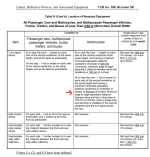Friend recently got a safety done for an R6 here in Ottawa.
Price across all motorcycle dealerships for the safety are $319 plus tax.
Failed for:
- Leaking right fork seal (shop was supposed to perform the fork service BEFORE the inspection but didn't)
- Front Tire (Enough tread, but aging and cracks visible)
- Rear rotor thickness (4.5mm thickness min. 4.48 measured)
- Tinted windscreen
- Fender Eliminator - They wanted the OEM "mud guard" fender in place - even though all 3 reflectors in place and turn signals properly mounted 9 inch apart.
Aftermarket Hindle exhaust wasn't an issue.
Hope this helps.
I've heard the 9in claim for turn signals before but I've only seen that mentioned in US laws not in the Ontario ones. If I am wrong though I'd like to know.
Source:
e-Laws | Ontario.ca
Lighting
6. (1) Prescribed lamps and reflectors shall be inspected and tested and,
(a) each circuit shall light the filaments of all lamps on the circuit when the appropriate switch is in the “ON” position, and each indicator lamp shall indicate correctly;
(b) the operation of any lighting circuit shall not interfere with the operation of any other circuit;
(c) each lens and reflex reflector shall be correctly installed and shall not be discoloured or missing in whole or in part;
(d) each lamp and reflector shall be securely mounted on the vehicle and none shall be missing;
(e) the turn signal lamps and the flasher unit shall operate properly;
(f) the brake light shall operate when the appropriate control is actuated;
(g) no headlamp shall be coated or covered with a coloured material except as permitted by section 4.1 of Regulation 596 of the Revised Regulations of Ontario, 1990;
(h) no headlamp shall be modified so that the effective area of the lens or brightness of the light is reduced;
(i) each headlamp shutter or retracting headlamp shall operate over the full range of movement or shall be secured in the fully open position; and
(j) no lens or lamp assembly shall bear markings that indicate “not for highway use” or a similar meaning.
(2) The headlamp, tail lamp and licence plate lamp on a motorcycle manufactured on or after the 1st day of January, 1975 shall be continuously illuminated when the engine is operating and each forward gear is engaged.
(3) The headlamp and dimmer switch shall be inspected and tested and, on a level surface after any noticeably deflated tires have been properly inflated, the headlamp alignment of the upper beam shall be inspected with a person seated on the operator’s seat and the front forks in the straight ahead position and,
(a) the headlamp shall be secure and the lens shall not be cracked or broken;
(b) the dimmer switch shall be operative; and
(c) the centre of the high-intensity zone of the beam shall be,
(i) not more than 100 millimetres above nor more than 100 millimetres below the horizontal centre-line of the lamp, and
(ii) not more than 200 millimetres to the left nor more than 200 millimetres to the right of the vertical centre-line of the lamp,
as measured on a screen placed eight metres in front of the lamp or by means of a headlamp testing machine.
(4) In addition to the lights and reflectors required to be inspected under this section, a motor tricycle shall be equipped with,
(a) two white or amber parking lamps or reflectors facing forward placed at the widest part of the vehicle, as far apart as practical, to indicate width; and
(b) two red reflectors facing rearwards placed at the widest part of the vehicle, as far apart as practical, to indicate width.
(5) The lamps and reflectors referred to in clauses (4) (a) and (b) shall be inspected and tested in accordance with subsection (1).
(6) Section 8 of Schedule 6.1, rather than this section, applies to a motor tricycle bearing a manufacturer’s compliance label issued under section 6 of the Motor Vehicle Safety Regulations (Canada) specifying the type of vehicle as “TRI” for motor tricycle.
R.R.O. 1990, Reg. 611, Sched. 6; O. Reg. 214/03, s. 2; O. Reg. 114/08, ss. 4-7.


















